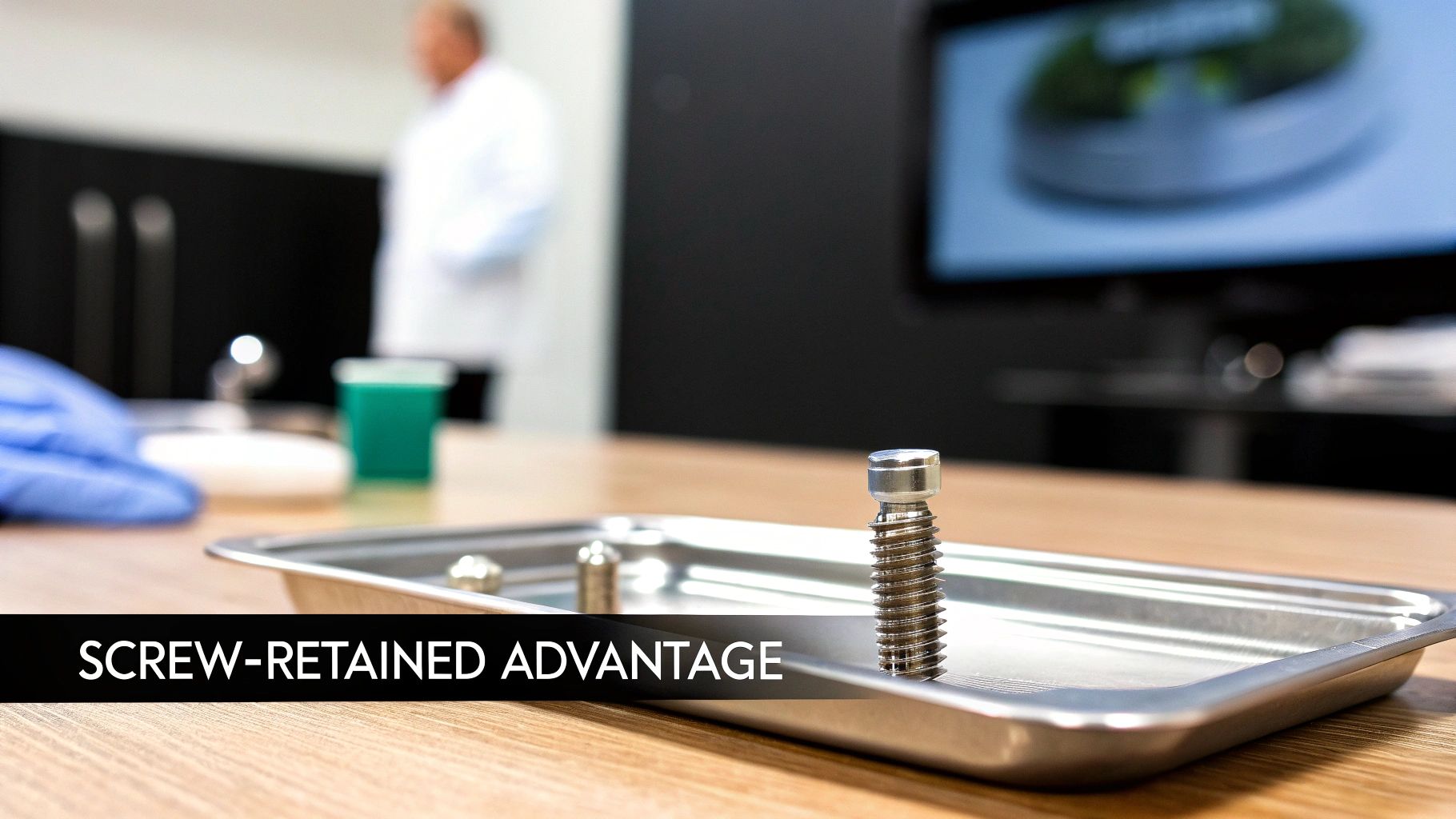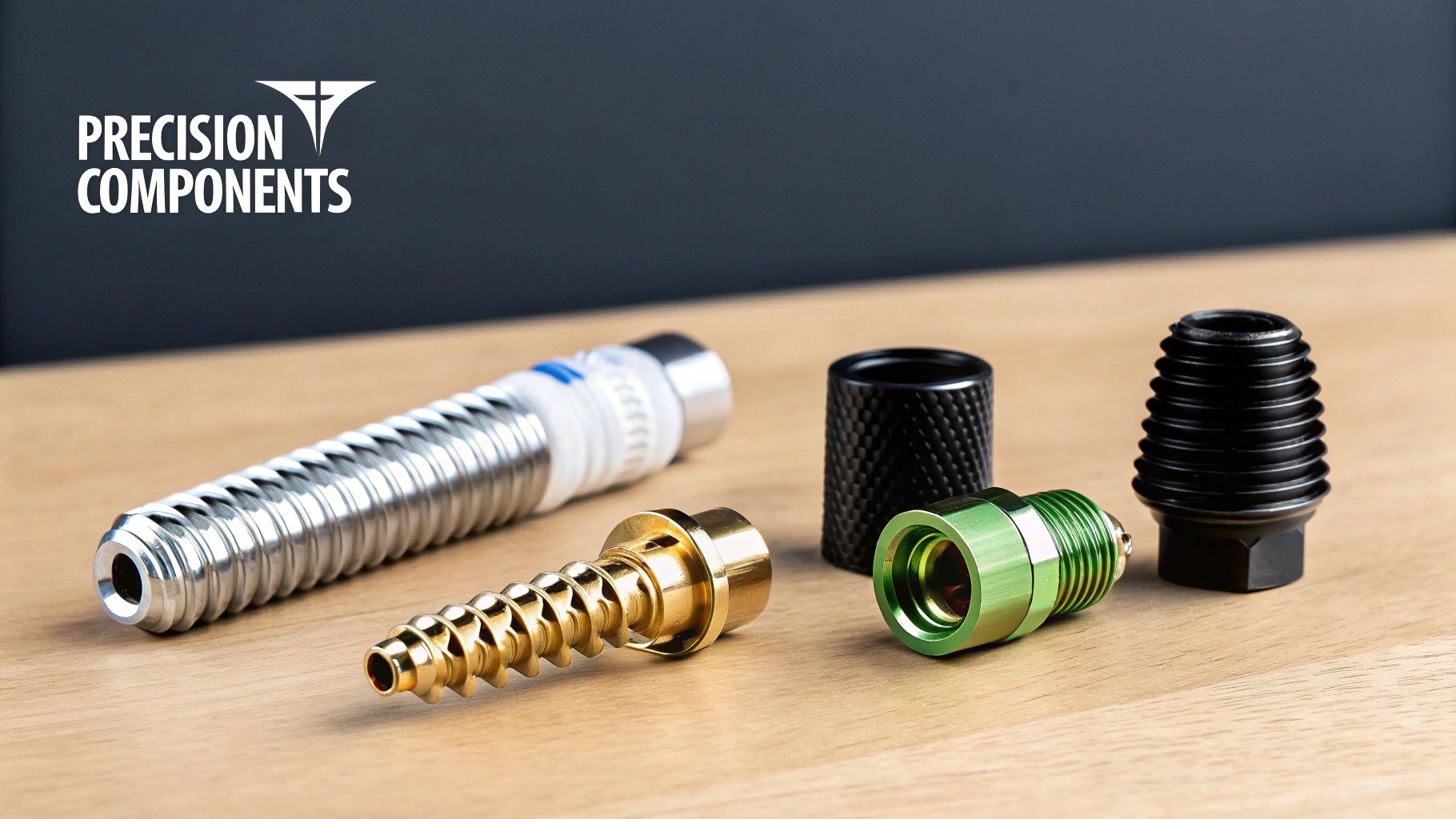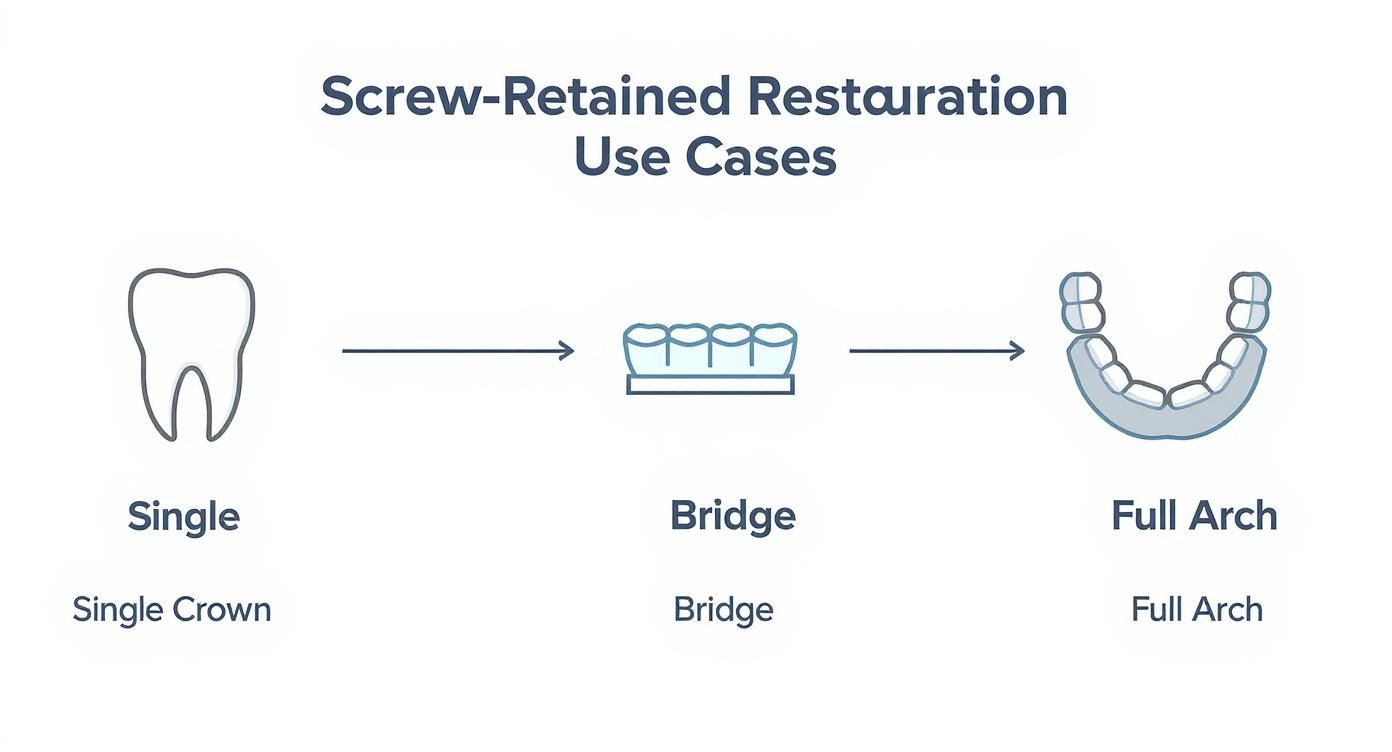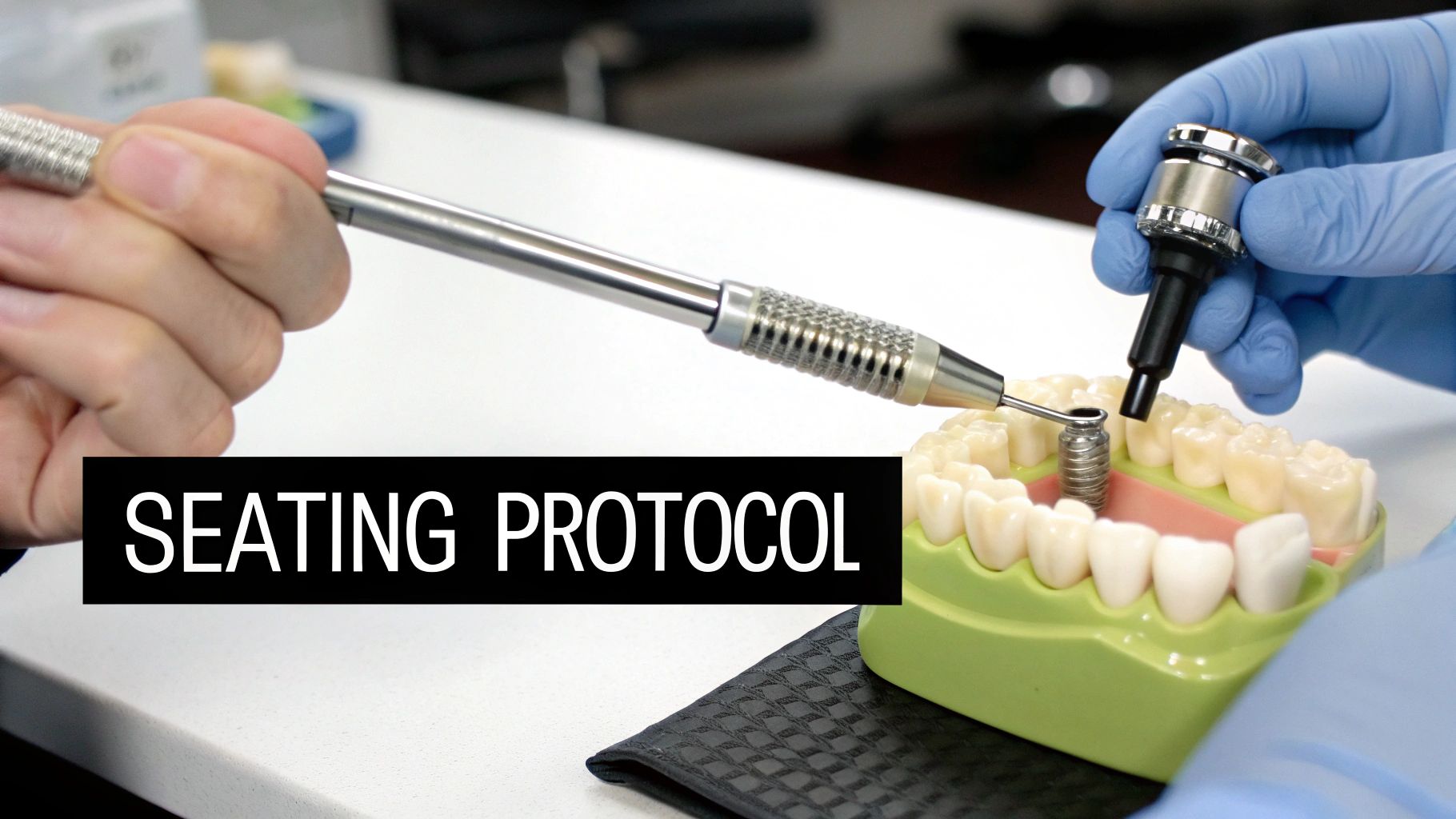A Clinician's Guide to the Straumann Screw-Retained Abutment
A Straumann screw-retained abutment is a high-precision prosthetic component that connects a dental restoration, such as a crown or bridge, directly to an implant fixture via a fixation screw. This design eliminates the need for dental cement, offering significant clinical advantages in terms of long-term maintenance, retrievability, and peri-implant tissue health. For these reasons, it has become a cornerstone of modern restorative dentistry, providing predictable and durable outcomes.
Why Screw-Retained Solutions Are a Clinical Gold Standard

In implant dentistry, the method of prosthesis fixation is as critical as achieving successful osseointegration. While cement-retained restorations have been widely used, screw-retained systems—particularly those engineered by pioneers like Straumann—are often the preferred choice for experienced clinicians. The primary reason for this preference is the superior clinical control and long-term risk management they afford.
The decision between a screw-retained and a cement-retained prosthesis is fundamentally about planning for the future of the restoration. A cemented crown may offer aesthetic advantages by eliminating the screw access channel. However, it introduces a significant clinical risk: the potential for retained subgingival cement. Excess cement is a well-documented etiologic factor for peri-mucositis and peri-implantitis, which can ultimately lead to implant failure.
The following table provides a concise comparison of these two restorative approaches.
Screw-Retained vs. Cement-Retained Abutments: A Comparison
| Feature | Screw-Retained | Cement-Retained |
|---|---|---|
| Retrievability | Excellent; easily removed for maintenance or repair. | Poor; often requires destroying the crown to access the implant. |
| Peri-Implant Health | Superior; no risk of subgingival cement excess. | High risk of peri-implantitis from residual cement. |
| Aesthetics | Good; screw access channel may need cosmetic filling. | Excellent; no access hole, creating a seamless look. |
| Clinical Complexity | Requires precise component and impression accuracy. | More forgiving of minor inaccuracies in fit. |
| Ideal Use Cases | Limited inter-arch space, single units, full-arch bridges. | Angled implants where screw access would be on the facial surface. |
As illustrated, while the choice is case-dependent, the advantages of a screw-retained approach often provide a clear clinical benefit for the long-term health and serviceability of the implant restoration.
The Advantage of Retrievability
The most significant clinical benefit of a screw-retained abutment is its retrievability. The ability to easily remove a restoration non-destructively is a powerful clinical tool that simplifies numerous procedures over the implant's lifespan.
This accessibility provides several practical advantages:
- Simplified Maintenance: If a prosthetic screw loosens, it can be tightened in a straightforward chairside procedure. Similarly, professional cleaning of the prosthesis and underlying tissues is facilitated.
- Effortless Repairs: In the event of porcelain chipping or other material failure, the prosthesis can be unscrewed, sent to the laboratory for repair, and predictably reseated.
- Prosthetic Upgrades: Should a patient's treatment plan evolve—for example, from a single crown to a multi-unit bridge—a screw-retained design allows for a much smoother transition.
This level of accessibility enables clinicians to manage prosthetic complications efficiently, often chairside. It enhances patient confidence and, most importantly, protects the underlying implant and supporting bone structure.
Promoting Peri-Implant Health
Beyond maintainability, the absence of cement is a critical factor in promoting long-term peri-implant tissue health. A Straumann screw-retained abutment eliminates the variable of undetected residual cement, which is particularly crucial in cases with deep subgingival margins where complete cleanup is difficult to verify.
By selecting a screw-retained solution, clinicians can deliver a restoration with the confidence that they are fostering a clean and healthy environment around the implant. This commitment to peri-implant health is fundamental to long-term success. At Alfa Gate, we offer a full range of prosthetic components, including high-quality abutments compatible with leading systems, to help you achieve these superior clinical outcomes.
Let's examine the key components and engineering principles of the Straumann screw-retained abutment.
Deconstructing the Straumann Screw-Retained Abutment

To appreciate the clinical efficacy of these abutments, one must understand the precision engineering behind them. The entire restorative assembly—implant, abutment, and crown—functions as a highly integrated system. Each component must fit and perform perfectly to ensure stability, durability, and a robust seal against bacterial ingress.
Each element has a specific function. The abutment body transmits occlusal forces from the crown down into the implant fixture. The prosthetic screw generates the clamping force (preload) that secures the assembly. The implant interface is the precision-machined connection that ensures a stable, anti-rotational fit. When all components are manufactured to exacting standards, they form a unified structure that performs reliably under functional load.
Understanding the Implant Connection
The connection between the abutment and the implant is arguably the most critical part of the system. Straumann has developed several connection types, each engineered for specific clinical scenarios and implant designs. A thorough understanding of these connections is essential for selecting the correct components for any given case.
These connections are not interchangeable; they are purpose-built to provide a specific type of seal and mechanical stability.
- CrossFit® Connection: This is the hallmark connection for Straumann’s Bone Level (BL) and Bone Level Tapered (BLT) implants. It features a conical portion for a friction-lock seal and four internal grooves for precise positioning and anti-rotation. This design provides excellent tactile feedback during placement and creates a secure, sealed interface at the bone level.
- Tissue Level (TL) Connection: A classic design in implantology, the TL implant incorporates a smooth collar that elevates the prosthetic connection to the tissue level. Its synOcta® connection uses an internal octagon for anti-rotation, simplifying prosthetic procedures by keeping the interface away from the bone.
- Bone Level (BL) Connection: This original BL connection is a butt-joint interface with an internal octagon. While largely superseded by the CrossFit® connection in newer implant lines, familiarity with this design is necessary for servicing older cases.
The choice of connection directly impacts biomechanical load distribution and the efficacy of the biological seal at the implant-abutment junction. A precise, stable fit minimizes micromovement, a known contributor to screw loosening and potential crestal bone loss.
Material Choices and Digital Integration
The materials used for abutments are as critical as their design. Traditional abutments are milled from high-strength, biocompatible titanium alloy. However, the rise of digital dentistry has led to the widespread adoption of hybrid solutions.
The Titanium-base (Ti-base) abutment exemplifies this trend. It consists of a precision-manufactured titanium base featuring the genuine Straumann connection, onto which a custom-milled zirconia or lithium disilicate restoration is bonded. This approach combines the guaranteed fit of an original component with the superior aesthetics of modern ceramics. Clinicians and laboratories can explore CAD/CAM workflows and prosthetic options in our detailed guide.
This hybrid methodology offers tremendous flexibility within digital workflows, allowing for highly customized emergence profiles and aesthetics without compromising the integrity of the critical implant-abutment connection.
For more information on our compatible solutions, Contact an Alfa Gate representative today to explore our full range of prosthetic components.
Clinical Indications for Screw-Retained Restorations
Understanding the components of a Straumann screw-retained abutment is essential, but the true clinical skill lies in knowing when to incorporate it into a treatment plan. This is a strategic decision that establishes the foundation for predictable, long-term restorative success.
The primary indication is any case where future retrievability is desired. This includes single posterior crowns, multi-unit bridges, and complex full-arch reconstructions. In these scenarios, the ability to simply unscrew the prosthesis for maintenance or repair without destroying it provides a significant clinical advantage.
Cases with Limited Interocclusal Space
One of the most definitive indications for a screw-retained restoration is limited interocclusal space. A cement-retained crown requires a minimum abutment height to achieve adequate mechanical retention. In cases with insufficient vertical space, this can be impossible to achieve.
A screw-retained design circumvents this issue entirely. Because the prosthetic screw provides the retention, a much lower-profile restoration can be fabricated. This makes it an ideal solution for posterior regions, where vertical space is often limited, ensuring a strong and durable result even in challenging anatomical situations.
Single Crowns and Multi-Unit Bridges
For single posterior crowns, screw retention is highly advantageous for long-term maintenance. If porcelain fractures years after placement, the crown can be unscrewed, repaired by the laboratory, and re-inserted. This is a more conservative and practical approach compared to sectioning a cemented crown, which almost always necessitates a complete remake.
The same principles apply to multi-unit bridges. Achieving a passive fit across multiple implants is critical to prevent undue stress on the fixtures and surrounding bone. A screw-retained bridge allows for confident verification of this passive fit at try-in. Furthermore, it simplifies future hygiene checks and soft tissue evaluation around the implants. To learn more about this process, you can find information on the abutment screw and its clinical management.
The Standard for Full-Arch Cases
In full-arch rehabilitations, such as "All-on-X" protocols, screw-retained prostheses are the undisputed gold standard. These complex restorations must be removed periodically for professional cleaning to maintain the health of the implants and underlying soft tissues. A screw-retained design is the only practical way to make this a simple and predictable chairside procedure.
For full-arch cases, the ability to retrieve the prosthesis is non-negotiable. It ensures the long-term viability of the entire reconstruction, transforming a potentially complex intervention into a straightforward maintenance appointment.
When to Reconsider Screw Retention
Despite their numerous benefits, screw-retained restorations are not the ideal solution for every clinical situation. The primary contraindication is in the aesthetic zone where an unfavorably angled implant would place the screw access channel on the facial surface of an anterior tooth.
While modern composite resins are effective at camouflaging the access hole, a slight shadow or discoloration can sometimes be unavoidable. In these highly visible areas where aesthetics are paramount, a cement-retained restoration may be the more appropriate choice to achieve a flawless outcome.
Navigating The Digital Abutment Workflow
Integrating the Straumann screw-retained abutment with a digital workflow transforms the restorative process into a seamless and highly accurate protocol. Instead of conventional impression materials, data is captured with intraoral scanners, allowing for near-instantaneous transfer from the clinic to the dental laboratory. This shift accelerates timelines and enhances collaboration between the clinician and technician, resulting in superior fit and aesthetics.
The process begins at the chairside. The clinician attaches a scan body—a precision-manufactured component—to the implant. An intraoral scanner is then used to capture its 3D position. The software records the implant's:
- Exact position
- Depth
- Rotational orientation
These coordinates serve as the digital foundation for the entire CAD design process.
From Digital Scan To Virtual Design
Once the scan is complete, the digital file is sent to the laboratory and imported into CAD software like 3Shape or Exocad. Here, the technician designs the virtual abutment and final restoration, meticulously shaping:
- Emergence profiles
- Soft tissue support
- Occlusal contacts
Each digital adjustment corresponds precisely to the patient's anatomy, ensuring the final restoration is not only aesthetic but also functionally optimized.

This workflow illustrates how single crowns, multi-unit bridges, and full-arch prostheses share the same digital foundation, from initial scan to final delivery.
The Role Of The Ti-Base In Fabrication
After the design is finalized, the restoration moves to the fabrication stage. The Ti-base (titanium base) is a genuine Straumann component that brings factory-level precision to a custom restoration. Its base engages the implant with a perfect fit, while its coronal portion is designed for bonding with a custom-milled ceramic superstructure.
Key benefits include:
- Guaranteed Fit: A genuine Ti-base ensures a passive, stress-free seating of the final restoration.
- Aesthetic Flexibility: Laboratories can mill the overlying crown from zirconia or lithium disilicate to meet aesthetic demands.
- Consistent Workflow: This system standardizes the fabrication of custom restorations, making it a routine and predictable process.
The Ti-base bridges the gap between the engineered precision of the implant connection and the custom aesthetics of the final crown, maintaining mechanical stability while leveraging the full advantages of a digital workflow.
This digital approach minimizes guesswork and reduces the potential for error. For a closer look at how laboratories utilize these technologies, explore our article on CAD/CAM Zahntechnik in Dental Labs.
Mastering the Prosthetic Seating Protocol

The long-term success of a Straumann screw-retained abutment is secured during the final clinical delivery. While digital design and milling provide exceptional precision, the seating appointment is where the restoration's stability is ultimately established. A meticulous protocol is essential to translate a well-fitting prosthesis into a durable, long-term success.
The procedure begins with verifying a completely passive fit. The restoration must seat fully on the implant interface without any binding, rocking, or resistance. This should be confirmed both visually and radiographically to ensure there are no microscopic gaps at the implant-abutment junction.
Achieving Optimal Preload with Torque Control
Once a passive fit is confirmed, the next step is to apply the correct torque to the prosthetic screw. The objective is not simply to tighten the screw but to achieve optimal preload. Preload is the clamping force that secures the abutment to the implant, and it is the most critical factor in preventing future screw loosening.
A calibrated torque wrench is an indispensable tool for this task. Every prosthetic screw is engineered to function within a specific torque range, typically between 15 Ncm and 35 Ncm, depending on the implant system and component specifications.
- Under-torquing: Fails to generate sufficient preload, leaving the screw susceptible to loosening under occlusal forces.
- Over-torquing: Can stress the screw beyond its elastic limit, leading to deformation, fracture, or damage to the implant's internal threads.
Always adhere strictly to the manufacturer’s recommended torque values. This precise force elongates the screw just enough to create a stable, locked connection that can withstand the dynamic forces of mastication.
The Final Steps: Sealing and Patient Education
After torquing the screw to the specified value, the screw access channel must be sealed. A small piece of inert material, such as PTFE tape or a cotton pellet, is placed over the screw head. This barrier facilitates clean and easy retrieval in the future. The opening is then sealed with composite resin.
Finally, patient education is critical. The patient must understand the importance of routine professional maintenance and proper home care. Clear instructions on hygiene protocols around the implant will help maintain healthy peri-implant tissues and ensure the longevity of the restoration. This combination of clinical precision and patient partnership is the foundation of successful outcomes.
Troubleshooting Common Clinical Challenges
Even with meticulous planning, clinical challenges can arise. When working with a Straumann screw-retained abutment, the ability to diagnose and manage common issues efficiently is key to maintaining the integrity of the prosthesis and patient confidence.
The most frequent complication is prosthetic screw loosening. While it is easy to attribute this to a faulty component, a loose screw is almost always a symptom of an underlying issue, typically related to improper torque, a non-passive fit, or occlusal overload. These factors create micro-movements that can gradually cause the screw to loosen.
Diagnosing Screw Loosening
When a patient presents with a mobile restoration, the first step is a thorough diagnosis, not simply re-tightening the screw. Addressing the root cause is essential for a lasting solution.
Consider the following potential causes:
- Insufficient Torque: Was the correct torque value applied with a calibrated instrument during the initial placement?
- Non-Passive Fit: Does the prosthesis seat perfectly without any rocking or binding? Even a minuscule discrepancy can induce stress and lead to loosening.
- Occlusal Overload: Evaluate the patient's occlusion. Are there heavy contacts in excursive movements? Is there evidence of parafunction, such as bruxism?
- Component Mismatch: Were genuine, compatible components used throughout the entire restorative stack? Using third-party parts can introduce micro-gaps that compromise stability.
A loose screw is a clinical indicator of a biomechanical imbalance. Simply re-torquing the screw without resolving the underlying issue will only provide a temporary fix.
Managing Aesthetic Concerns
Another challenge, particularly in the anterior region, is the aesthetic management of the screw access hole. While modern composites are excellent for camouflaging the opening, a greyish hue from the underlying metal can sometimes become visible.
A simple technique to prevent this is to place an opaque material, such as white PTFE tape, over the screw head before placing the final layer of composite. This barrier effectively blocks the dark metal from showing through the translucent restorative material, significantly improving the final aesthetic result.
By mastering these troubleshooting protocols, clinicians can confidently manage complications, ensuring every screw-retained restoration meets both functional and aesthetic expectations.
Common Questions from the Clinic
This section addresses frequently asked questions regarding the clinical use of Straumann screw-retained abutments, providing clear, actionable answers for dentists, dental students, and distributors.
Can I Reuse a Prosthetic Screw?
No. A prosthetic screw should never be reused for final torque.
When a new screw is torqued to its specified value, it undergoes slight elastic deformation. This elongation generates the critical clamping force (preload) that secures the abutment. A reused screw has already been subjected to these forces and is metallurgically fatigued. Re-torquing it carries a significantly higher risk of screw loosening or fracture under functional load.
For predictable mechanical stability, always use a new, sterile screw for the final prosthesis delivery.
What’s the Real Difference Between Engaging and Non-Engaging Abutments?
The distinction lies in the presence of an anti-rotational feature at the implant-abutment interface.
- Engaging abutments incorporate a feature (e.g., a hexagon or octagon) that locks into the corresponding internal geometry of the implant. This is mandatory for single-unit crowns to prevent them from rotating.
- Non-engaging abutments have a flat, smooth interface at their base. They do not engage the implant's anti-rotational feature. Their exclusive application is for splinted bridges or full-arch restorations. In these cases, the prosthesis framework itself provides the anti-rotation, and the flat interface allows for a passive fit across multiple, potentially non-parallel implants.
An engaging abutment is essential for the stability and orientation of a single crown. For a multi-unit prosthesis, non-engaging abutments are equally critical for achieving a stress-free, passive fit.
What Do I Do If a Screw Head Gets Stripped?
A stripped screw head can be a challenging clinical situation, but it is typically manageable with the appropriate retrieval kit.
These specialized kits contain reverse-threaded drills and taps designed to grip the damaged screw, allowing the clinician to carefully back it out of the implant without damaging the internal threads. The best approach, however, is prevention. Ensure that driver tips are in excellent condition and are fully seated within the screw head before applying any rotational force.
For clinicians seeking reliable, high-quality components designed to minimize such complications, the prosthetic components available from Alfa Gate are an excellent choice for any dental practice.
Ready to provide predictable, reliable implant solutions for your patients? Alfa Gate offers a complete portfolio of advanced implant systems and prosthetic components engineered for clinical success. To learn more or to connect with our team, please visit our Contact Us page.
Explore our full range of products at Alfa-Gate.us today.
Article created using Outrank







